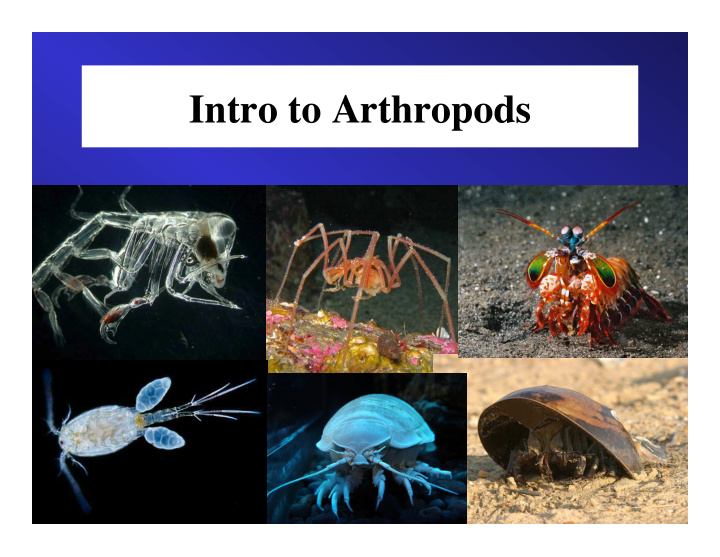



Intro to Arthropods
Defining Characteristics • Complete loss of motile cilia in adult and larval stages • Epidermis produces a segmented, jointed, and hardened (sclerotized) chitinous exoskeleton , with intrinsic musculature between individual joints of appendages
Epicuticle : outer layer- waxy, thin, made of lipid and proteins Procuticle : inner layer- thick, strong, made of chitin and proteins
General External Anatomy of a Crustacean
Subphylum Chelicerata Class Arachnida Class Merostomata Class Pycnogonida
Class Merostomata • Primarily extinct species - Only 4 living • Horseshoe crab ( Limulus polyphemus ) • All marine • Have appendages on the opisthosoma known as “ book gills ” that are flattened and modified for gas exchange • Telson drawn out into spike
Class Pycnogonida • Sea spiders - all species are marine • Very long legs (3-16 times body) • Body not divided into distinct regions • Unique proboscis at the anterior end • Variable numbers of walking legs among species • Ovigers
Class Pycnogonida
Subphylum Mandibulata • Bear mandibles on the head segment that are modified for chewing or grinding food • Includes 3 classes; Myriapoda (centipedes & millipedes), Insecta, and Crustacea
Class Crustacea • 45,000 crustacean species • Divided among 6 major subclasses • Head bears 5 appendages including 2 pairs of antennae • Development includes a larval form called a nauplius.
Subclass Malacostraca • ¾ of the known crustaceans • Total of 19 body segments: 5 in the head, 8 in the thorax, and 6-7 in the abdomen plus a telson • Diverse variations on this basic body plan; modifications basis for taxonomy
Subclass Malacostraca • Most familiar forms: – Shrimps – Crabs – Lobsters
“ Lobster ”
“ Crab ”
“ Shrimp ”
Characteristics of the Malacostraca • Total of 19 body segments – Five head • (Characteristic of Crustacea) – Eight thorax – Six abdominal
General External Anatomy of a Crustacean
Head Appendages • First antenna (antennule) – chemosensory • Second antenna – Tactile • Modifications: swimming, grasping mates, feeding, defense
Antenna 1 Antenna 2 D. Perrine
Head Appendages • Mandibles – Shred food • First maxilla (maxillule) – Food manipulation • Second maxilla – Food manipulation – Gill bailer- scaphognathite; drives respiratory currents
Thoracic Appendages Maxillipeds modified to function as mouthparts Pereopods used for locomotion: walking or swimming
Abdominal Appendages Pleopods ( “ swimmerets ” ) swimming, generating respiratory current, also egg bearing Uropods last pair of abdominal appendages; combine with telson to form tail fan
Order Euphausiacea • Krill, Euphausiids • 85 species worldwide • All marine; open ocean
Euphausiid- krill No maxillipeds; eight pairs of undifferentiated legs- used to form filtering basket for straining water for food
Order Isopoda Isopods Woodlice Pillbugs • 10,000 species • Only terrestrial malacostracans • Some are parasites • Most common deep sea malacostracans (1.5 ft) • Males reduced; live in female pouch or attached to antennae
Order Amphipoda • Sand fleas, skeleton shrimp • 6,000 species • Freshwater; caves & underground streams • Shallow temperate marine water
Isopods & Amphipods 1 pair of maxillipeds; leaving 7 thoracic legs Mysid CAS
Order Stomatopoda • Mantis shrimp • 350 species • Voracious predators http://video.google.com/videoplay? docid=2500843136893486803&q=mantis+shrimp&ei=uWQeSI- PMITmrQOFz_WrAQ
Stomatopods- mantis shrimps 5 pairs of maxillipeds; three pairs of legs
Order Decapoda • 10,000 species • Shrimp, crab, hermit crabs, lobsters
Decapods- crabs, shrimps, lobsters 3 pairs of maxillipeds; five pairs of legs deca = 10, pod = foot
Include penaeid & sergestid shrimp; only decapods that do not brood More shrimp American lobster & freshwater crayfish Spiny lobsters Mud & ghost shrimp, hermit crabs, king crabs, squat lobsters, porcelain crabs, sand crabs Spider, cancer, green, mud, pea, & fiddler crabs
Subclass Branchiopoda • Diverse, small, primarily freshwater crustaceans; water fleas ( Daphnia ) and brine shrimp ( Artemia ) • Thoracic appendages modified to form large flattened paddles; functions in gas exchange and locomotion
Subclass Ostracoda • Marine and freshwater • Head and body are enclosed in a partially calcified, bivalve carapace • Most species are free living, some commensal with other crustaceans or echinoderms http://images.google.com/imgres?imgurl=http://w3.gre.ac.uk/schools/nri/earth/ostracod/introimages/morph5.gif&imgrefurl=http://w3.gre.ac.uk/schools/nri/earth/ostracod/ introduction.htm&h=572&w=571&sz=48&hl=en&start=19&sig2=dJoUcbS5fyfX30sgmaxXVw&um=1&tbnid=ISuAncbZTJYq- M:&tbnh=134&tbnw=134&ei=ylYeSNrvLKSMggPUvMW4Cw&prev=/images%3Fq%3Dchelate%2Bappendage%26start%3D18%26ndsp%3D18%26um%3D1%26hl%3Den%26rlz %3D1B3GGGL_enUS243US243%26sa%3DN
Subclass Copepoda • Most abundant animals on earth • 8,500 species • Most marine and feed on phytoplankton; major component of zooplankton & base of food chain • Lack gills and abdominal appendages
Subclass Cirripedia • Exclusively marine • highly modified for attachment to hard substrates • Lack abdominal segments, gills, & heart • Modified thoracic appendages called cirri used for filter feeding • Shell composed of numerous plates
General External Anatomy of a Crustacean
Recommend
More recommend